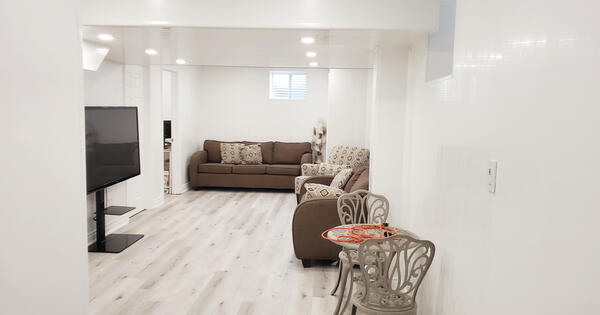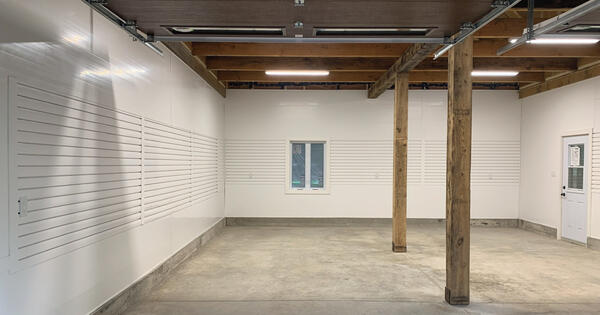So, you've found yourself staring up at that popcorn ceiling and wondering how to give it a modern makeover? You're in the right place. Popcorn ceilings, also known as acoustic or textured ceilings, were once popular for their ability to dampen noise and hide imperfections. But these days, they're more likely to elicit groans than admiration. If you're ready to bid farewell to that dated look, covering it up is a practical and achievable DIY project that can breathe new life into your space.
Preparing to Cover a Popcorn Ceiling
Before you grab your tools, take a moment to assess the condition of your popcorn ceiling. To begin, grab a sturdy ladder and a flashlight. Carefully inspect the popcorn ceiling for any signs of damage, such as cracks, stains, or areas where the texture is flaking off. Pay close attention to corners and edges where water damage might be more prevalent.
Use your fingers or a putty knife to gently press on various sections of the ceiling. If you notice any soft spots or areas that feel unstable, it could indicate water damage or underlying structural issues. Look for discoloration or mold growth, especially in areas prone to moisture, like bathrooms or kitchens. Mold growth on a popcorn ceiling can be a sign of a significant moisture problem and should be addressed promptly.
If the texture is intact, you're good to go. However, if your home was built before the late 1970s, it's crucial to consider the possibility of asbestos. Popcorn ceilings installed before this time may contain asbestos fibers, which can be harmful if disturbed. To be safe, have a sample tested for asbestos before proceeding with any renovations.
Once you've confirmed the safety of your ceiling, gather your tools and materials. You'll need basic supplies like drop cloths, painter's tape, sandpaper, and a ladder. Depending on your chosen covering method, additional materials such as drywall, beadboard, or PVC panels may be required.

Popcorn Ceiling Removal vs. Covering
Now comes the big decision: do you remove the popcorn texture altogether or cover it up? Let's break down the pros and cons of both removing and covering a popcorn ceiling, as well as why covering might be the preferred method for many homeowners.
Pros and Cons of Removing Popcorn Ceiling
While removal might seem like the obvious choice, it can be a messy and time-consuming process, not to mention the potential health risks if asbestos is present.
| Pros | Cons |
|---|---|
|
Modernization: Removing popcorn texture can instantly update the look of a room, giving it a more contemporary and streamlined appearance. Increased Ceiling Height: Smooth ceilings can create an illusion of higher ceilings, making a space feel more open and spacious. Easier Maintenance: Smooth ceilings are typically easier to clean and maintain compared to textured surfaces, as they don't trap dust and debris as readily. Potential Increase in Property Value: Removing popcorn ceilings may improve the overall aesthetic appeal of your home, potentially increasing its resale value. |
Labor-Intensive: Scraping off popcorn texture can be a time-consuming and physically demanding task, especially if the ceiling is large or has multiple layers of texture. Mess and Dust: The removal process can generate a significant amount of dust and debris, which may require extensive cleanup and proper containment to avoid spreading throughout the home. Potential for Damage: There's a risk of damaging the ceiling or underlying drywall during the removal process, especially if not done carefully or by inexperienced individuals. Asbestos Concerns: If the popcorn ceiling contains asbestos, removal can pose health risks if not handled properly, requiring professional abatement services. |
Pros and Cons of Covering Popcorn Ceiling
Covering the popcorn ceiling, on the other hand, offers a less invasive solution that can yield impressive results with less hassle.
| Pros | Cons |
|---|---|
|
Cost-Effective: Covering a popcorn ceiling is often more budget-friendly than removing it, as it requires fewer materials and less labor. Time-Saving: The process of covering a popcorn ceiling is generally quicker and less labor-intensive compared to removal, making it a more manageable DIY project for many homeowners. Conceals Imperfections: Covering the textured surface with a new material, such as drywall, beadboard, or ceiling tiles, can effectively hide any imperfections or damage present in the popcorn texture. Minimizes Asbestos Risk: If the popcorn ceiling contains asbestos and removal is not feasible or too costly, covering it with a new material can safely encapsulate the asbestos-containing texture, reducing the risk of exposure. |
Reduced Ceiling Height: Adding a new layer over the popcorn texture may slightly lower the ceiling height, potentially making the space feel slightly smaller. Limited Design Options: While covering a popcorn ceiling can improve its appearance, it may not provide the same level of customization or design flexibility as removing the texture altogether. Potential for Cracking: Depending on the covering material used and the condition of the existing popcorn texture, there's a risk of cracks or other issues developing over time, especially if the underlying surface is uneven or damaged. Difficulty in Repairing: If the covered ceiling sustains damage or requires repairs in the future, it may be more challenging to access and address compared to a smooth ceiling surface. |
Ultimately, the decision to remove or cover a popcorn ceiling depends on factors such as budget, time constraints, aesthetic preferences, and safety considerations. It's essential for homeowners to weigh the pros and cons of each method carefully before proceeding with their chosen approach.
Popcorn Ceiling Covering Options
When it comes to covering popcorn ceilings, you've got a variety of options to choose from:
- Drywall: Drywall involves installing sheets of gypsum board to create a smooth and seamless ceiling surface. This method offers durability and can be painted to match any desired color scheme. However, proper installation techniques are crucial to ensure a flat and even surface, and the process can be labor-intensive with lots of waste and dust created during installation.
- Beadboard: Beadboard consists of narrow planks with a tongue-and-groove design that interlocks for easy installation. This method adds a charming and timeless aesthetic to the space and can be painted or stained to match various decor styles. However, precise measurements and cutting are required to fit around obstacles, and visible seams between panels may be a challenge.
- Skim Coating: Skim coating involves applying a thin layer of joint compound or plaster over the existing popcorn texture to create a smooth finish. This method can be customized to achieve different textures or patterns and requires minimal materials and tools for application. However, skill and experience are needed to achieve a professional-looking finish, and the process can be time-consuming with dust and mess associated with sanding and finishing.
- PVC Wall Panels: Pre-finished PVC panels like Trusscore Wall&CeilingBoard are lightweight, easy to install, and don’t require any mudding, taping, priming, or painting as part of the installation process. Trusscore panels can also be installed directly on top of drywall or popcorn ceilings without creating any mess or dust. Plus, if you’re getting rid of a popcorn ceiling in a basement or bathroom, you won’t have to worry about mold or mildew growing – the panels are 100% moisture and water resistant.



Tips for Selecting Materials Based on Budget and Aesthetic Preferences
Consider your budget, timeline, and aesthetic preferences when selecting the right covering method for your space:
- Determine your budget: Consider the cost of materials, tools, and any additional supplies needed for installation when selecting covering materials.
- Explore different aesthetics: Take inspiration from home decor magazines, websites, and social media platforms to find the look and style that best suits your preferences.
- Consider maintenance and durability: Choose materials that are easy to clean and maintain, especially in high-traffic areas like kitchens and living rooms.
- Seek professional advice: Consult with experts at home improvement stores or seek guidance from contractors to help you choose the right materials for your project.
- Compare prices and quality: Don't always opt for the cheapest option; consider the overall value and quality of materials to ensure long-lasting results.
How to Cover a Popcorn Ceiling with Trusscore Wall&CeilingBoard
Ready to tackle your popcorn ceiling makeover with a pre-finished product that doesn’t require any extra steps? Here's how to cover up a popcorn ceiling with Trusscore Wall&CeilingBoard:
- Cut the first panel of the first course shorter. Position it so the screw flange points away from the wall. Make sure the panel runs parallel to the outside wall before you fasten it. Measure both ends, and if they're equal, the panel is parallel.
- Leave a 1/8" gap between the tongue side of the panel and the wall. Fasten it at least once every 24" with the right screws. Remember to leave 1/4" of clearance at both ends for expansion and contraction. Don't tighten the screws too much.
- If your ceiling is longer than the panels, join them in the middle using the H Channel Snap-In Kit.
- After installing the first panel row, immediately install the J Trim for the top of the wall below. Push the trim tight to the panel(s) with the channel facing away from them and fasten it to the wall. This supports the unfastened side of the panel. Cut the trim 1/2" short in one corner. Avoid using Inside Cove Corner Trim for the top or bottom of walls.
- Once the first panel row is up, install the rest of the ceiling panels. Insert the tongue of the second panel into the groove of the first panel. Press them firmly together for a good connection. Then, fasten the most recent panel.
- Check your installation regularly to ensure straight, even rows. Measure the distance from the wall to the edge of your panels at both ends. If the measurements match, it's aligned. If not, adjust the board's position.
- The last panel might need trimming. Make sure there's a 1/8" gap between the trimmed edge and the wall.
- Install the last panel by inserting it into the groove of the previous one. Then, immediately install the J Trim for the top of the wall below. Push it tight to the panel with the channel facing away and fasten it to the wall. This supports the last panel.
For more information about installing Trusscore Wall&CeilingBoard on the ceiling, download our Trusscore Wall&CeilingBoard installation guide.
Covering a popcorn ceiling may seem like a daunting task, but with the right tools, materials, and know-how, it's entirely achievable for DIY enthusiasts of all skill levels. Whether you opt for PVC, beadboard, or another covering method, the result will be a refreshed space that reflects your personal style and enhances the overall aesthetic of your home.






